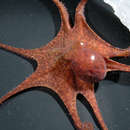en
names in breadcrumbs


Octopus oliveri, is a species of octopus found in the western Pacific Ocean off the coast of Japan, Hawaii, and Kermadec Island, in reefs and boulder coasts.[1][2]
It is a small species, roughly 70-260mm in length.[2] Females will take longer to mate, the larger their body size.[2][3] Afterwards, ~5000 eggs will hatch in about five weeks after being laid, and the male/female ratio seems unaffected by temperature. These eggs are laid in strings attached to a hard substrate.[2][4]
Octopus oliveri, is a species of octopus found in the western Pacific Ocean off the coast of Japan, Hawaii, and Kermadec Island, in reefs and boulder coasts.
It is a small species, roughly 70-260mm in length. Females will take longer to mate, the larger their body size. Afterwards, ~5000 eggs will hatch in about five weeks after being laid, and the male/female ratio seems unaffected by temperature. These eggs are laid in strings attached to a hard substrate.